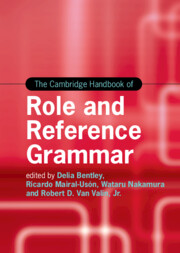Book contents
- The Cambridge Handbook of Role and Reference Grammar
- Cambridge Handbooks in Language and Linguistics
- The Cambridge Handbook of Role and Reference Grammar
- Copyright page
- Dedication
- Contents
- Figures
- Tables
- Contributors
- Pedagogical Guide to The Cambridge Handbook of Role and Reference Grammar
- Introduction
- Part One Overview
- Part Two Topics in RRG: Simple Sentences
- 2 Lexical and Grammatical Categories in RRG
- 3 A Conceptually Oriented Approach to Semantic Composition in RRG
- 4 Semantic Macroroles
- 5 Grammatical Relations
- 6 Argument Structure Alternations
- 7 Case Assignment
- 8 Morphology in RRG
- 9 Adverbs, Mimetics and Ideophones
- 10 Adposition Assignment and Adpositional Phrase Types in RRG
- 11 The RRG Approach to Information Structure
- 12 Information Structure and Argument Linking
- Part Three Topics in RRG: Complex Sentences
- Part Four Applications of RRG
- Part Five Grammatical Sketches
- Index
- References
7 - Case Assignment
from Part Two - Topics in RRG: Simple Sentences
Published online by Cambridge University Press: 08 June 2023
- The Cambridge Handbook of Role and Reference Grammar
- Cambridge Handbooks in Language and Linguistics
- The Cambridge Handbook of Role and Reference Grammar
- Copyright page
- Dedication
- Contents
- Figures
- Tables
- Contributors
- Pedagogical Guide to The Cambridge Handbook of Role and Reference Grammar
- Introduction
- Part One Overview
- Part Two Topics in RRG: Simple Sentences
- 2 Lexical and Grammatical Categories in RRG
- 3 A Conceptually Oriented Approach to Semantic Composition in RRG
- 4 Semantic Macroroles
- 5 Grammatical Relations
- 6 Argument Structure Alternations
- 7 Case Assignment
- 8 Morphology in RRG
- 9 Adverbs, Mimetics and Ideophones
- 10 Adposition Assignment and Adpositional Phrase Types in RRG
- 11 The RRG Approach to Information Structure
- 12 Information Structure and Argument Linking
- Part Three Topics in RRG: Complex Sentences
- Part Four Applications of RRG
- Part Five Grammatical Sketches
- Index
- References
Summary
This chapter explicates the Role and Reference Grammar (RRG) theory of case assignment and outlines its OT implementation and its extension to instrumental case assignment and case syncretism. The ’non-OT’ theory of case assignment in RRG is a version of dependent case theory that assigns nominative, accusative, absolutive and ergative case in terms of the ranking of actor and undergoer, while its OT-based counterpart defines accusative, ergative, dative and instrumental case with reference to (non-)macrorole status, conflates nominative and absolutive as an any-argument case, and derives the variation of case syncretism from the case hierarchy of Silverstein (1980/1993).
Information
- Type
- Chapter
- Information
- The Cambridge Handbook of Role and Reference Grammar , pp. 318 - 367Publisher: Cambridge University PressPrint publication year: 2023
